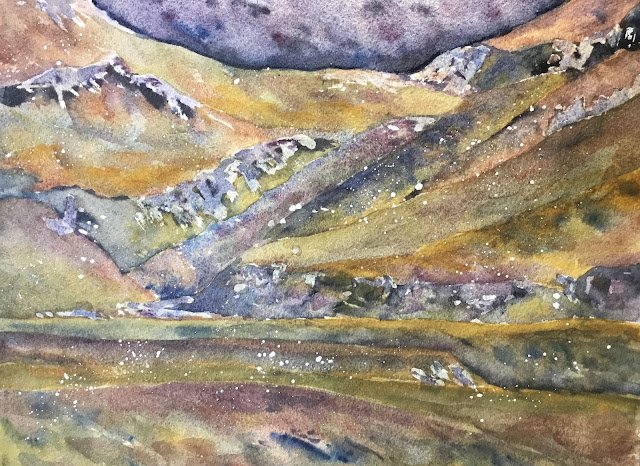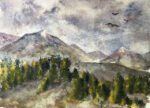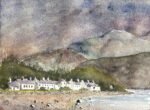The rain's finally stopped, so I'm back on the watercolours at last. I thought I'd…

Tundra Colours
This painting was long overdue. I’d had these tundra colours for a while and had painted a few snowy scenes in Nuuk, Greenland plus the odd U.K. scene where they’ve added a certain hill to the air. But I’d not actually painted a tundra landscape. I didn’t even know what a tundra landscape looked like until today. But I did some googling, found a scene and painted it.
This one uses the five tundra colours plus raw sienna. The greens in my source photo were more yellow than the tundra set could match, so I thought I should bring in one yellow. I’ve used cadmium yellow with this set in the past but that was for the odd bright green here and there. With the amount of green in this painting, though, I needed to use a transparent yellow. I went for raw sienna simply because it was the closest match in my palette to the yellow ochre in the tundra green. With yellow ochre being warm and raw sienna cool, this painting can’t be classified under any particular colour key.
So, first things first. A pencil outline, some masked out white bits and a spattering of masking fluid. Then I put down an underpainting with only a very rough connection to my source photo. I only used the five tundra colours at this stage but tried to keep things interesting by charging in the odd wet into wet mark hoping for some granulation effects.
Then I added a second layer. This layer paid much more attention to the colours in my source photo and included lots of raw sienna wherever the greens were most yellow. But, most importantly, in this layer I was defining edges properly, making the top edges of all the hillside shapes sharp. I worked through one shape at a time, working from top to bottom but skipping shapes so that I wasn’t painting in one shape while the adjacent shape was still wet. When I reached the bottom I went back to the top and started filling in shapes I’d missed. It took me three top to bottom sweeps to complete all the shapes.
I added a third layer, wry similar to the second, adding more colour where the values or hues needed adjusting or where edges needed to be better defined. The dark shape at the top was looking too dark, so it was in this stage that I wet it, dabbed off paint and added in some more interesting, lighter colours. There was probably some more tinkering but I see this as layer 3.2 rather than layer 4.
Layer 4 did eventually arrive though. After I removed the masking fluid, the white shapes were (as expected, to be honest) a bit too white, so I dropped in some random tundra colours to bring them back a bit.
I stared at the painting for a while, wondering whether there was enough distinction between the foreground and background planes and whether I should perform the titanium white trick to add some texture to the closest hills to make them appear closer. But I decided that this would be too risky and that the painting was fine as it was. So that was me done.
I think I ended up with a decent enough painting. The colours and the granulating effects are interesting. The Schmincke supergranulators are like a cheat code – it’s almost impossible to go wrong with them. And definitely impossible to go wrong with the tundra supergranulators. While the colours are interesting, I’m not sure I can say the same about the shapes although saying that there’s a hint of an eye in the top left. This one was in the shop window at one point but has since been taken down in a quality purge.








Leave a Reply